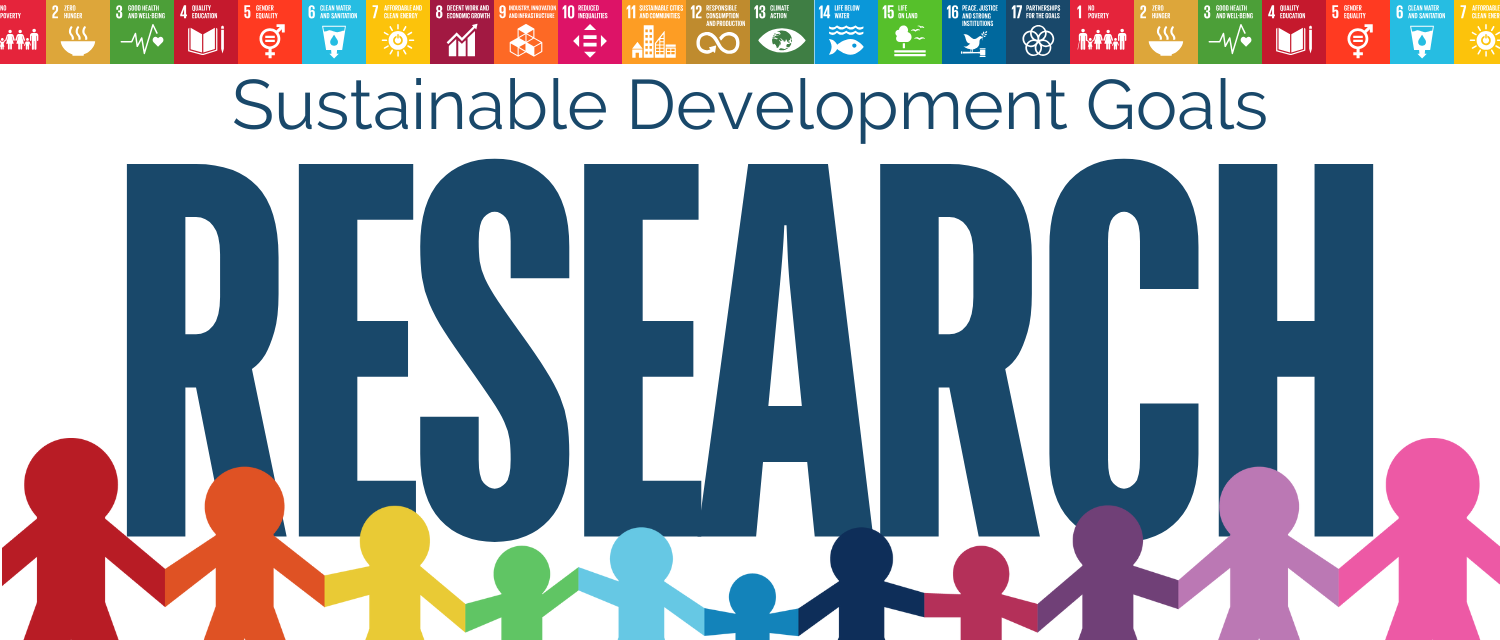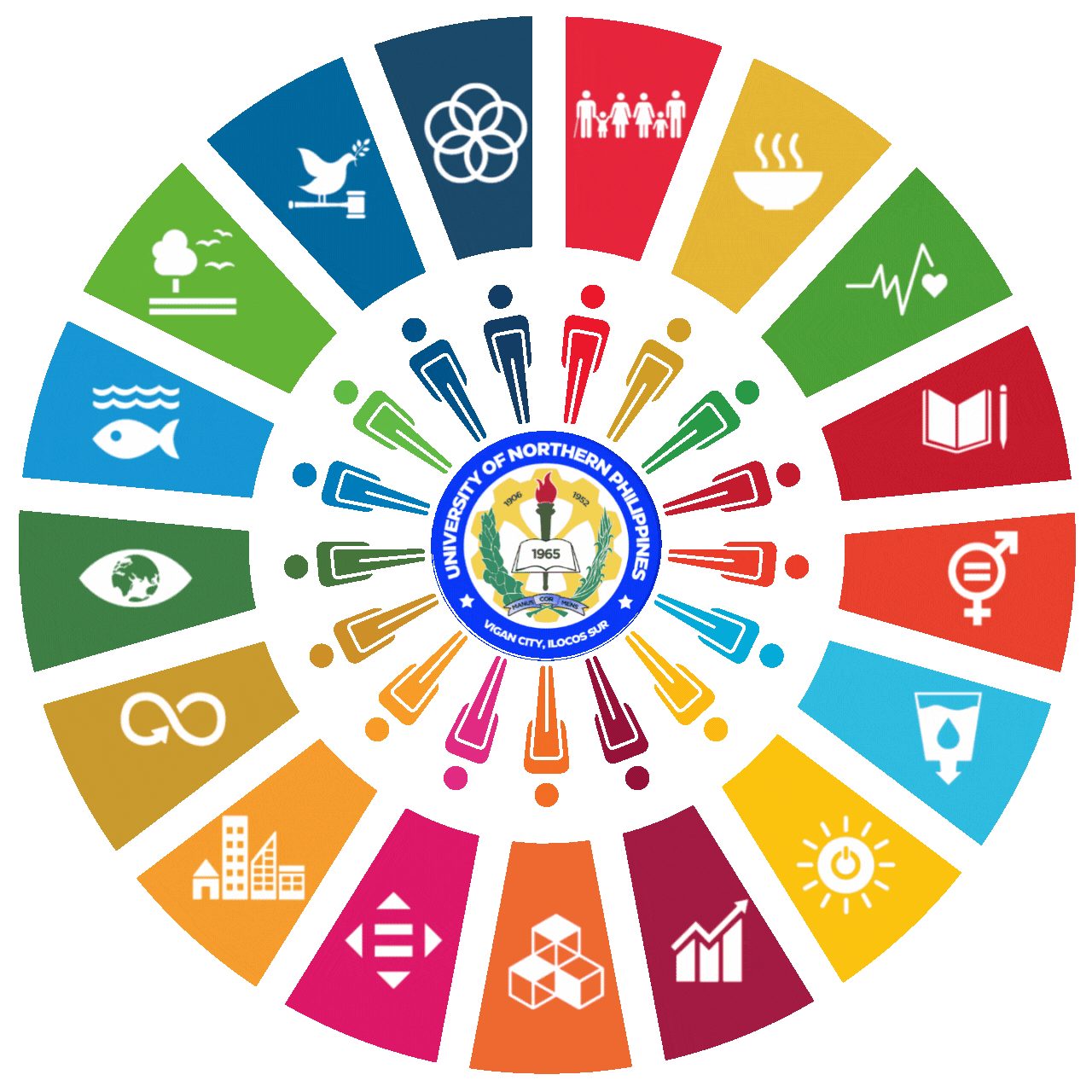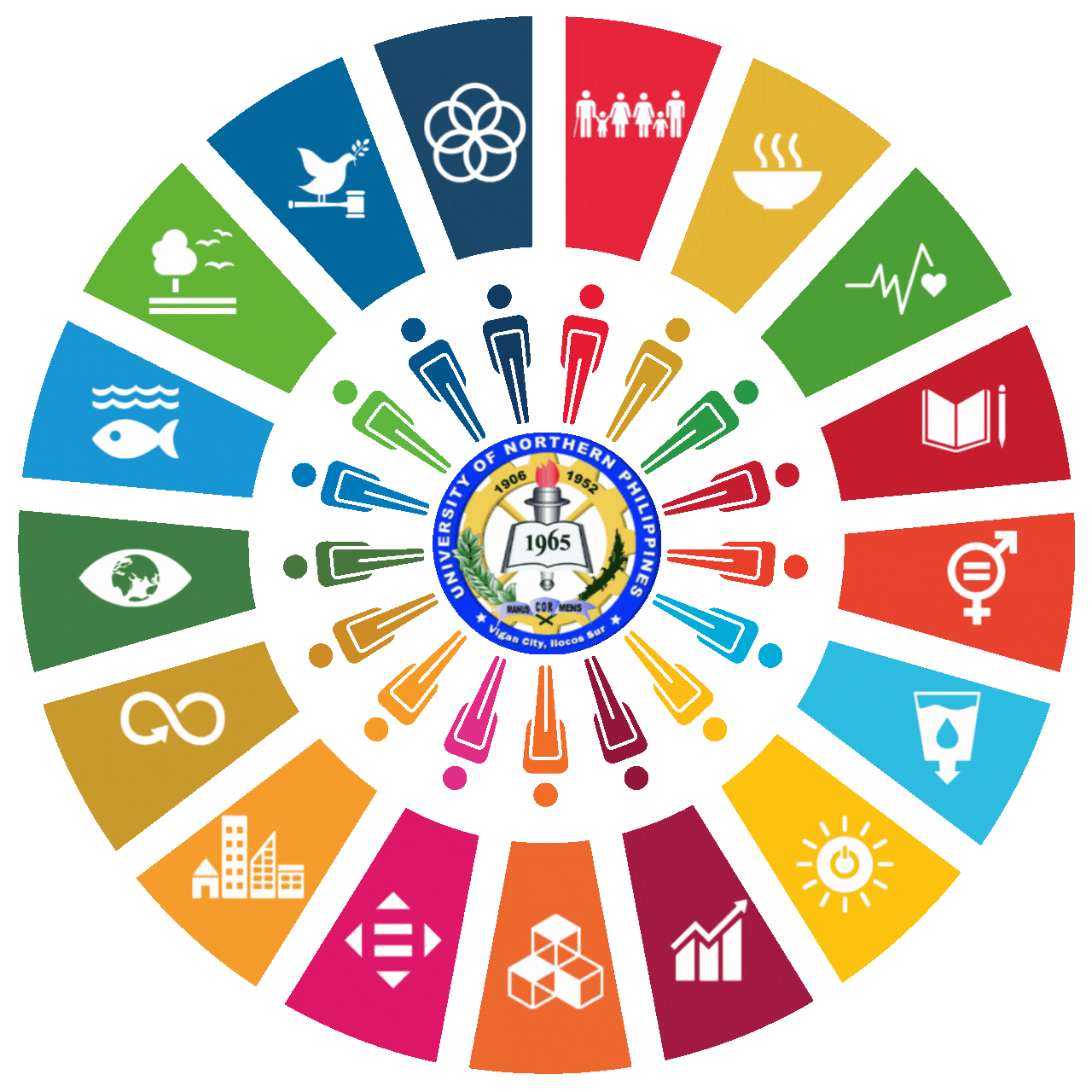

SDG 17 - PARTNERSHIP FOR THE GOALS
The University of Northern Philippines (UNP) demonstrates a strong commitment to Sustainable Development Goal 17: Partnerships for the Goals through its comprehensive approach in forming collaborations, and partnerships at local, national, and international levels.
Taxonomy of Insects in San Juan, Ilcoos Sur, Philippines
Proponents: KITZ A. ELECHO, JOSHUA A. BATARA, VIRGILIO B. GASCON, MARITESS R. RABOY, ALMA B. SEGISMUNDO, JESSY C. DOMINGO
Abstract
Considered the most diverse animal group on the planet, insects play significant roles in the production of essential seeds, fruits, and vegetables through pollination, decomposition of organic matter, control of populations of other organisms, and provision of food for other taxa, including humans. This study aimed to conduct a taxonomic study of insects in San Juan, Ilocos Sur, Philippines, and classify them as to order family, scientific name, common name, and species richness between the two study areas, Barbar and Immayos Sur. One hundred forty-one (141) adult insects were collected and taxonomically classified employing the latest classification schemes and identification keys from authoritative individuals and databases from credible websites, as well as catalogs, checklists, synopses, and other reliable published references. Of these 141 specimens, which the researchers purely identified, some still need to be adequately identified, including those fifty-six (56) species identified at the family level, sixty-five (65) valid genera, and thirty-two (32) species that were marked ‘INDET’ (indeterminable) but were identified at least at the family level or tribal
level. Twenty-four (24) species are suspected to be new, and a comparison of these with the collections in Natural History Museums is highly recommended for their verification. A tabulated classification of insects occurring in San Juan, Ilocos Sur is presented. In terms of species richness, there are more insect species in the forests and water ecosystems of Barbar than in Immayos Sur, San Juan, Ilocos Sur.
Keywords: species, order, scientific name, species richness
Contextualization and Localization of Teaching Mathematics in the New Normal
Proponents: John Paul G. Fabrigas, Joseph G. Taban
Abstract
To understand how contextualization and localization have been applied to mathematics instruction, this study explored the effects of the shift in the educational paradigm brought about by the COVID-19 pandemic. This research determined the extent of implementation of contextualization and localization in teaching Mathematics among the Mathematics teachers in the fourteen schools in the El Nido Del Norte and Del Sur Districts in the new normal. Mixed methods, quantitative, and qualitative research designs were employed using a survey questionnaire as the primary data-gathering tool and a semi-structured interview guide. The level of implementation of contextualization and localization in teaching Mathematics, specifically in terms of assessment tools and instructional materials, was found to be “High.” It was found that creating localized materials was challenging among teaching teachers because it required translating materials into local languages, especially since there are multiple languages spoken in the area. However, teachers receive support from administrators, colleagues, parents, and the community to overcome challenges. Based on these findings, recommendations made in the study included regular professional development, building a community of practice, research and evaluation, policy and technology support, involving parents/local community, and monitoring and feedback.
Keywords: Contextualization, localization, teaching Mathematics, adversities, coping mechanisms
Climate Fiction for the Classroom through Ecocriticism and Collaborative Digital Text Annotation
Proponents: Agata Cristine E. Cabrera, Crissa Mae I. Agsalog, Ronnel C. Ibea, Ofelia E. Tara, Jolysa Rose A. Corpuz, Mark Louie Tabunan
Abstract
This study took a humanities approach to climate change education, focusing on climate fiction texts in the literature classroom, namely: Barakat Akinsiku’s “The God of the Sea,” Sigrid Marianne Gayangos’s “Galansiyang,” and Jules Hogan’s “Those They Left Behind” from Everything Change: An Anthology of Climate Fiction, Volume III (2021). This encompassed the Quarter 3, Week 7 literature competency in the DepEd Grade 10 curriculum context. In-depth discussion of the cli-fi texts was made possible through the crafting of a lesson exemplar, writing of discussion questions through an ecocritical lens, and using Collaborative Digital Text Annotation (CDTA) as an evaluative reading tool which engendered student responses to the text and interactions within the CDTA activity. Thematic analysis was used in interpreting the digital text annotations which revealed four different themes: drawing out story elements, connecting the text to the real world, performing evaluative reading, and expressing random reactions under which the students’ responses to the cli-fi texts were classified. The researchers recommend using online applications such as Google Docs as
digital annotation tools during collaborative classroom reading. Also, literature classroom facilitators should create a concrete reward system to encourage students’ enthusiasm during the CDTA activities and to achieve the collaborative aspect of the CDTA. Lastly, other reading strategies for evaluating cli-fi texts must be explored.
Keywords: climate change education, interdisciplinary literature instruction, technology-based learning, ecocriticism
Mainstreaming Ambisyon Natin 2040 and Sustainable Development Goals in the University of Northern Philippines
Proponents: Erwin F. Cadorna, Joselito D. Dela Rosa, Archie Martinez
Abstract
The United Nations, including the Philippines, adopted the 2015 Sustainable Development Agenda, which includes seventeen Sustainable Development Goals (SDGs) and 169 targets to be achieved by 2030. The University of Northern Philippines (UNP) takes pride in its image as an institution of global quality. As a higher education institution, it is committed to contribute to the attainment of the Sustainable Development Goals (SDGs) of the United Nations and the Philippines AmBisyon Nation 2040 goals in improving a lot of humanity and the world. This study aimed to analyze the mainstreaming of AmBisyon Natin 2040 and SDGs in UNP. It described activities under the 12 University’s development goals aligned to the AmBisyon Natin 2040 and SDGs and proposed a plan to sustain and strengthen them. Documentary analysis revealed that the University development goals, with feasible, practical, and doable activities, are allegiance to all the goals of the Philippines’ AmBisyon Natin 2040 and the United Nations’ Sustainable Development Goals. Other state universities and colleges may replicate this research undertaking to have a written account and inventory of their endeavors as a testament of compliance and commitment to achieving the goals of AmBisyon Natin 2040 and SDGs.
Keywords: mainstreaming, sustainable development goals, AmBisyon Natin 2040, higher education.
Assessment of the Community Well-Being in Ilocos Sur, Philippines: A Basis for Health Extension Plan
Proponents: Epifania Marlene R. Purisima, Jevie A. Abella, Raymund Christopher dela Pena, Edna R. Javier
Abstract
This descriptive quantitative study determined the level of community well-being among the residents of Brgy. Napo, Sto. Domingo, Ilocos Sur, involving all 149 family heads. The dependent variables are the five areas of community well-being: Clean and Green, Growth and Prosperity, Healthy Lifestyle, Safety and Security, Sense of Community, and Sustainable and Connected Transport. The independent variables comprise their socio-demographic profile. An adapted questionnaire checklist was utilized in gathering data. The mean and percentage we used to analyze the data gathered. It was found that hypertension and heart attack are the leading cause of morbidity and mortality, respectively. Their community well-being is high, along with the sense of community, sustainable and connected transport, clean and green, safety and security, and growth and prosperity. However, their community well-being and healthy lifestyle are low. Based on the study’s findings, the following recommendations are made: 1) Support from the local government unit along livelihood
programs, high-quality broadband, and sound policy framework on digital networks, and digital skill training; 2) support for low-income families by non-government organizations; 3) execution of the health extension plan, the “Healthy NA’PO! Project,” by the University of Northern Philippines and 4) Conduct of qualitative study for future research.
Keywords: Community Well-being, Assessment, Health Extension Plan
The Science Teachers Engagement via Extension (SciTEE) Project: An Impact Study Using the Model of Change
Proponents: Edelyn Alicar Cadorna, Erwin Frando Cadorna, Janet Tabasan Molina
Abstract
Using the theory of change, the impact of the Science Teachers Enhancement via Extension (SciTEE) Project of a state university in the northern part of Luzon, Philippines, was evaluated. Through the mixed method of research, the study investigated the extension profile, project level of implementation, outputs, outcomes, and impact after being implemented for five years. The participants of the different extension activities were the respondents. The process of triangulation was utilized to gather the data needed. Through the project, the beneficiaries enriched their knowledge of selected science content, developed their ICT skills in teaching, acquired knowledge and skills on the proper use of science equipment, and developed their skills in research and in making instructional
materials. The Project contributed to the capacity building of the beneficiaries, their social and economic development, lifelong learning skills, and generally contributing to the global goal of preparing teachers for 21st-century learning.
Keywords: 21st-century teaching skills, model of change, extension program, teacher enhancement, impact assessment.
Cultural Tangible Properties: The Development of the Candon Heritage Resources conservation Plan
Proponents: Ludivina Abaya Lozano
Abstract
The City of Candon in Ilocos Sur, Philippines, is rich in culturally built heritage, particularly houses of ancestry. The City identifies ancestral houses, while other buildings and structures are not included in the list but can already be considered part of the culturally built heritage. Collectively, these cultural resources are within a proposed heritage district of the City, including a heritage growth corridor–where the high concentration of such resources is located — that may serve as a visual representation and act as a living museum of the area. This study formulated a proposed Heritage Resources Conservation Plan to preserve and protect the identified built heritage resources in Candon City. A field survey was conducted to identify and map the local heritage resources and their cultural significance. Upon identification of the City’s heritage district, several guidelines regarding further development in the area, especially along the heritage corridor, were recommended to preserve and protect these cultural resources from possible deterioration and destruction.
Keywords: Cultural Tourism, Heritage Zone, Built Heritage, Local heritage Resources
Indigenous Knowledge Systems and Practices (IKSP) in Disaster Risk Reduction and Management of Secondary Schools in Indigenous Cultural Communities in Abra, Philippines
Proponents: Rhoda P. Asencio, Edelyn A. Cadorna
Abstract
Indigenous knowledge systems and practices (IKSP) are utilized by the Indigenous Cultural Communities (ICC) to mitigate the impact of disasters. This study determined the IKSPs in disaster risk reduction and management (DRRM) of the secondary schools in the selected indigenous communities in Abra, Philippines. It employed a mixed-method explanatory sequential research design. Data were gathered using surveys and interviews. Findings showed that the schools in the ICCs utilized their IKSPs to manage disasters along the four thematic areas of DRRM: prevention and mitigation, preparedness, response, recovery, and rehabilitation. IKSPs, as part of disaster management, include utilizing local plants, observing the behaviors of some animals and insects, observing the colors of the clouds, and performing rituals by the elders in the community. Furthermore, the result of the study revealed these IKSPs emerged to be essential in the prevention and mitigation, preparedness, response, recovery, and rehabilitation during disasters such as; “Alluyon,” “Ganap,” “Komon,” “Sagubay,” Ubaya,” ” Senga,” “Lapat System,” “Agamang,” “Bodong” and “Dap- Ay.”
Keywords: Indigenous Knowledge, Maeng, Lapat, Explanatory design, Abra.
Beyond Tangible: Vigan City's Binatbatan Festival: Basis for a Policy Brief
Proponent: Henryson A. Fetalvero
Abstract
Festival conveys encouraging influence in drawing tourists, improving image of destination and supporting local communities. This study scanned “Binatbatan” festival of Vigan City from the point of view of organizers and visitors. Through a case study, the qualitative method was employed to understand the Festival underscoring, its origin, celebration schemes and the challenges on the people and the place, magnifying management strategies for ordinance implementation on various activity related to the culture and tradition of the locality. A Focus Group Discussions and interviews of respondents and visitors conducted were interpreted. The study realized that Festivals evolve through informal sociability; planning and coordination, as well as control, were vital, creating avenues for cultural and artistic appreciation and the formation of social capital, that the festivals shares four common success factors of ambiance, socialization, emotion and reflection; and that planning, budgeting, coordination, promotion as well as control were vital to the celebrations and that festivals created avenues for job generation, cultural and artistic appreciation and formation of social capital. Based on the findings, policy brief that act on the challenges met by the organizers in managing the festivals, were proposed.
Keywords: Festival, Case Study, Event’s Challenges Sustainability, Policy Brief
Votive Offerings for Miracles: Ex-Votos for Apo Lakay at the Simbaan a Bassit in Vigan City
Proponent: Ashley Paulino S. Martinez
Abstract
The study is about the practice of offering silver votive offering also known as ex-voto of the Ilocanos at the Simbaan a Bassit in response to a divine intervention to a health concern in return for a hoped miracle, or a thanksgiving for graces received in answer to a prayer. These religious folk charms that are traditionally used for healing purposes both by individuals and by the community. The research design is a descriptive qualitative method of research using the semiotics and hermeneutics tools in analyzing data. Results show that those who practice religious activities tend to have a greater healing capability. It also showsthat individuals who regularly participate in spiritual worship services or related activities firmly believe that spirituality or the presence of a higher being in power are sources of strength and comfort to them are healthier and possess greater healing capabilities. The premise that the ex-voto is the solemn promise of the supplicant to Apo Lakay in time of difficulty, illness, or to give thanks for granted petition is a concrete testimonial of the fulfillment of the vow. Ex-voto as a memorial practice can relate to both the past and the present, as current public demonstrations of health-gratitude or health-awareness extend beyond the divine, the shrine, and their community. The votive offerings are the material embodiment of the miracle itself.
Keywords: Votive / Ex-voto, Apo Lakay, Coping mechanism, Divine intervention
Initial Inventory and Documentation of Stone/Brick-and-Lime Vats (Baldi) in Some Northern Towns of the Province of Ilocos Sur, Philippines
Proponent: Fatima Nicetas Alonzo
Abstract
This is an initial inventory and documentation of remaining, abandoned and non-functioning vats, locally referred to as baldi, in some northern towns of Ilocos Sur, many of which are in various states of human-mediated damage and natural deterioration. It was undertaken by faculty proponents and students of the College of Architecture of the University of Northern Philippines, Vigan City with a local anthropologist for the period 2017 to 2018. The research sought to establish the significance of the vats in the cultural life of the province. As a descriptive method of research of the qualitative type, the project basically aimed to identify the location of the vats, determine their construction methodology and materials of construction, inscribe their architectural character and features, evaluate their current physical condition and contexts, and ascertain their ownership. The information gathered is structured and presented in a summary of 1) Inventory, in tables, 2) Graphical presentation, 3) Photographs and 4) Description of vat attributes. There are 63 (7 of which could not be measured and could only be photographed) inventoried vats, excluding wells and other features in a few vat assemblages in 17 vat sites (12 of which with visible vat assemblages [sites that include two or more vats]), in 10 barangays of 8 towns (Sinait, Cabugao, San Juan, Magsingal, Santo Domingo, San Ildefonso, San Vicente, and Bantay).
Preliminary Notes from Oral History and Literature on the Baldi of Ilocos Sur, Philippines
Proponents: M.L. I. Ingel, Fatima Nicetas A. Rabang-Alonzo, Uldarico A. Pacada, G.A. Retuta and Renato B.Navarro
Abstract
Stone or brick-and-lime vats locally referred to as baldi occur across the province of Ilocos Sur, Philippines. Many of the baldi must have been constructed for the purpose of natural indigo dye production from the locally-grown indigo plant. This was important to the Ilocos economy and contributed to the wealth of the historic town of Vigan listed as a UNESCO World Heritage Site. However, some vats had been used for different production activities, including those that apparently changed function at certain points in time, attributable to the shifts in the economy of the region. Most or all of the vats had ceased being utilized for livelihood-related production since around the 1960s or even earlier. Overall, the vats should be viewed not as generic cultural features with a single function, but as tangible cultural heritage that must have had a variety of functions across space and time given site-specific and dynamic environmental, economic, and cultural contexts. They merit further historical-archaeological research, particularly in relation to the history of Vigan.
Keywords: baldi, indigo vats, indigo dye, built heritage, heritage protection


















